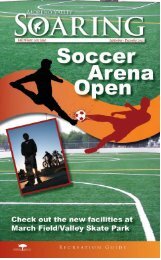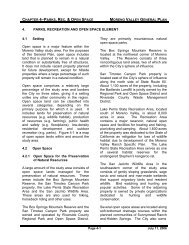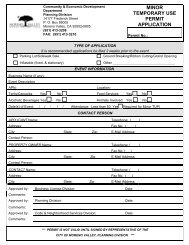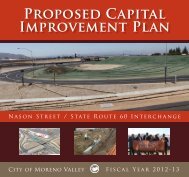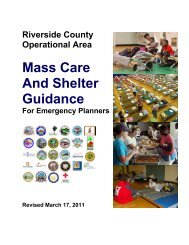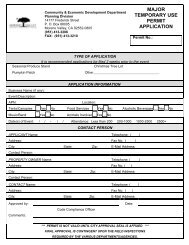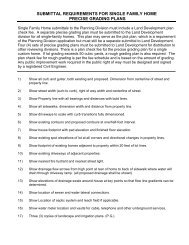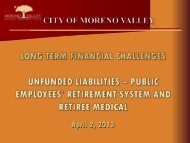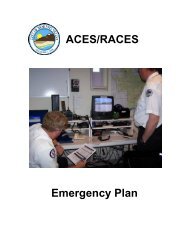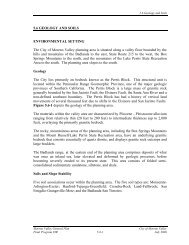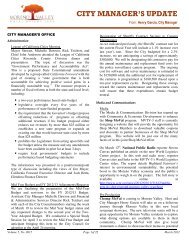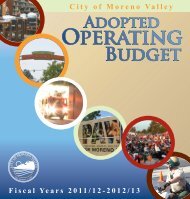General Plan - Moreno Valley
General Plan - Moreno Valley
General Plan - Moreno Valley
Create successful ePaper yourself
Turn your PDF publications into a flip-book with our unique Google optimized e-Paper software.
CHAPTER 6 – SAFETYbasin is the primary air quality problem in<strong>Moreno</strong> <strong>Valley</strong>.Atmospheric temperature inversions thatoccur above the South Coast Air Basin alsoaffect local air quality. Air pollutantsconcentrate because they cannot risethrough the inversion layer and disperse.Inversions are more common and persistentduring the summer months. Over time,sunlight produces photochemical reactionsthat create ozone, a particularly harmful airpollutant.Ozone, carbon monoxide, fine particulatematter, nitrogen dioxide, sulfur dioxide andlead are pollutants for which the federal andstate governments have established ambientoutdoor air quality standards. Air qualitystandards are designed to protect publichealth. There are also federal and stateregulations concerning toxic pollutants andglobal warming and ozone-depleting gases.Ozone is formed by the reaction of volatileorganic compounds and reactive organicgases, both of which are by-products ofvehicular and industrial emissions. Carbonmonoxide from motor vehicle emissions canreach high levels near congested roadways.Fine particulate matter is a pollutant thatconsists of very small particles derived fromsoil surface dust, diesel soot and othersources. Nitrogen dioxide, a by-product ofmotor vehicle and industrial emissions, sulfurdioxide and lead are found at levels belowthe federal and state standards.Air quality data is obtained from monitoringstations operated by the South Coast AirQuality Management District (AQMD). ThePerris <strong>Valley</strong> station is the closest and mostrepresentative of the study area. The Perris<strong>Valley</strong> station monitors fine particulate matterand ozone, <strong>Moreno</strong> <strong>Valley</strong>'s primary airquality problem.Although <strong>Moreno</strong> <strong>Valley</strong>'s air quality isgreatly shaped by pollutants transported fromother portions of the Basin, <strong>Moreno</strong> <strong>Valley</strong>MORENO VALLEY GENERAL PLANhas both stationary and mobile sources ofemissions. Stationary sources includeresidences, dry cleaning establishments, gasstations and various manufacturingenterprises.Mobile sources include automobiles, trucks,buses and aircraft traveling within orthrough the study area. Mobile sourceemissions are regulated to some degree atthe state and federal levels by emissionstandards for auto manufacturers and bythe state mandatory automobile inspectionprogram.The SCAQMD is the regional agencycreated to achieve and maintain healthful airin the region in accordance with federal andstate mandates. SCAQMD must adopt,update and implement an Air QualityManagement <strong>Plan</strong> (AQMP) pursuant to theCalifornia Clean Air Act and the federalClean Air Act. The AQMP mustdemonstrate compliance with state andfederal air quality standards.Implementation of air pollution controlmeasures dramatically improved air quality inthe region since the early 1970’s. Reflectinga long-term trend of improved air qualitybetween 1985 and 1999, there was a 75percent reduction in the number of days ofunhealthful air. In 1985, there were nearly160 unhealthful air days, days when thefederal standard for ozone (0.12 parts permillion) was exceeded. There were 41 daysof unhealthful air in 1999.6.6.2. Issues and OpportunitiesFuture development within the study area willcreate air pollutant emissions from threesources: construction, mobile, and stationary.Construction impacts are temporary, andinclude dust and gaseous emissionsresulting from the disturbance of soil duringclearing and grading as well as thecombustion of fuels from heavy equipment.Page 6-20 July 11, 2006



